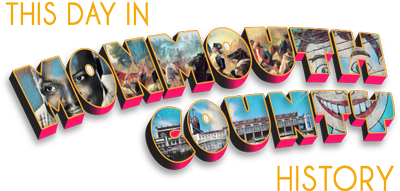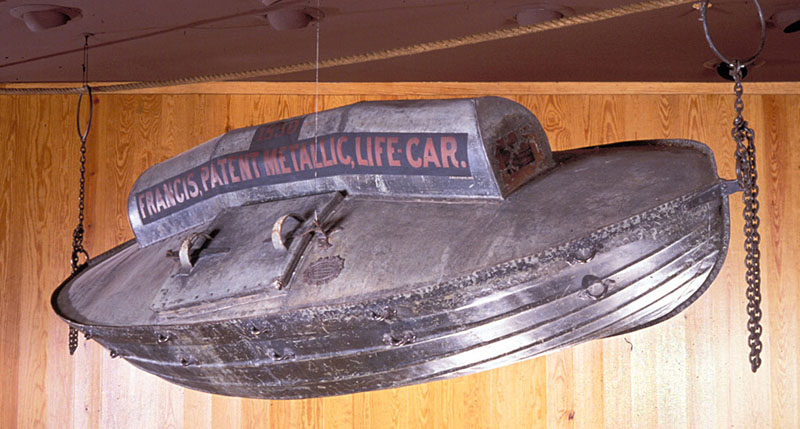On June 18, 1878, Congress passed a new law that created the U.S. Life-Saving Service as a part of the Treasury Department. Prior to then, it was included within a long-gone bureau of the federal government known as the Treasury Department’s Revenue Marine Division.
Federal funding in 1848 is often presented as the formal beginning of the U.S. Life-Saving Service, but in fact, it be 30 years before the federal government would finally assert meaningful and effective control over the handling of shore-based marine rescue and salvage.
Prior to this, all attempts to effect shore-based rescue efforts when ships wrecked close to shore in Monmouth County were handled by county-appointed Commissioners of Wrecks, also known as “wreck-masters,” who were paid a stipend and operated according to an evolving state law that governed the handling of shipwrecks.
Click here to read An Early Legislative History of New Jersey State Law Concerning Wrecks.
The appropriation that eventually became known as the “Newell Act,” for its sponsor (but which was not an actual Act of legislation, merely an appropriation of funds), funded the construction of eight boathouses that covered just beyond the first three wreck-master districts, about ten miles apart, with new sheds constructed at Sandy Hook (Spermaceti Cove), Long Branch, Deal, Spring Lake, Squan Beach, Island Beach, Barnegat and Long Beach Island. They were completed by May of 1849.
Each boathouse measured 28 x 16 feet, with a second story, and was situated such that its main doors faced away from the southwest, so that the heavy winds from the typical nor-easter storms of our region could not prevent the doors from being opened so the boat could be deployed.
Each boathouse had ten critical pieces of equipment. In addition to the surfboat and oars, each shed featured a surfboat wagon with iron wheels. Each shed had a Manby mortar, a type of mortar created to shoot a special shot with a rope attached, and an assortment of ropes and wires for use with the Francis Life-Car.
Lifesaving stations such as those from Sandy Hook to Egg Harbor initially were manned by full-time crews only from November to April on the east coast, the “active season.” By the turn of the century, the active season was year-round. Most stations were in isolated areas and crewmen had to be able to launch their boats from the beach into the surf. Before the turn of the century, there were very few recreational boaters and most assistance cases came to the aid of ships engaged in commerce.
The lifesaving stations featured self-bailing, self-righting surf boats of varying size, rowed by six surfmen. The surfboat could be pulled on a cart by crewmen, or horses, to a site near a wreck and then launched into the surf. The lifeboat, following a design originated in England, could be fitted with sails for work further offshore and was used in very heavy weather. Some crews, at first, viewed the lifeboat with skepticism because of its great weight and bulk. The skepticism soon changed and crews began to regard it as “something almost supernatural,” for it enabled them to provide assistance “when the most powerful tugs and steam-craft refused to go out of the harbor.”
When a ship wrecked close to shore and the seas were too rough for boats, then the Service could use Life-Cars. Patented by Joseph Francis in 1845, the Francis Life-Car was one of the most successful life-preserving devices developed at the time. Buoyant from a covering of cork, the pod-shaped metal life-car was used to rescue shipwreck victims when the vessel was foundering near land. While standing on the beach, a person from a lifesaving station used a cannon-like gun to shoot sturdy lines out to the ship, which would then be tied to the ship’s mast. The life-car was attached to, and pulled, along these lines. Up to four people were bolted into the airtight compartment. They laid flat as they were hauled through the rough waters to the safety of the shore. This device rescued at least thousands of people on the New Jersey shore alone, as well as countless amounts of valuable cargo.
Monmouth County Wreck-Masters
By 1846, the Jersey shore was divided into five districts for the purposes of having an organized approach to rendering assistance to ships in distress close to shore. District 1 extended from Sandy Hook to Long Branch, with Henry Wardell and James Green as appointed wreck-masters. District 2 ran from Long Branch to Manasquan Inlet, overseen by John Remsen and Edwin Dennis; District 3, under Hugh Johnson, to a now-gone inlet located near Seaside Park; District 4 extended from there to Barnegat Inlet, with Joseph Lawrence as wreck-master; and District 5 covered the remaining shoreline to Cape May; the name of that wreck-master has been lost to history.
There were noteworthy successes for this system, but there were also tragic failures, owing to a long list of reasons that extend to the ship in distress and those aboard as well as those on shore attempting to render assistance. For example, all but one of the 201 people aboard the Ayrshire were successfully rescued using this system, but all of the people aboard the Powhattan perished, with little effort made to render any assistance.
But within five years, the forces of nature were taking their toll on the life-saving equipment. Life-Cars were rusting, wagons had fallen into disrepair, and the required ropes and wires needed to operate the Life-Cars were also in bad shape.
Congress, however, had other priorities during these years, including the Civil War, and so little was done to improve the prospects for the wreck-masters of Monmouth County and beyond.
Finally, on April 20, 1871, Congress provided new funding to the Treasury Department to respond to the national outrage of the continued loss of life along the coastlines of America. Sumner I. Kimball was appointed general superintendent of the new service.
Through this act, 29 new life-saving stations were constructed, and these were not simple sheds, these structures included living quarters for the station-keeper and crew, and were intended to serve as a place of shelter for shipwreck survivors.
Standardized procedures for deploying surf boats and Life-Cars were put into place, and paid crews were expected to drill and rehearse various rescue scenarios so that they would be best able to render assistance effectively. The stations were subjected to regular inspections to ensure they were in good condition with all required equipment on hand and in good condition.
Kimball also saw the need for a better way of getting a rope from shore to a ship in distress, with better range and accuracy. He assigned this project to U.S. Army Lt. David A. Lyle (1845–1937), a graduate of West Point and the Massachusetts Institute of Technology, and an expert in artillery at the Fort Hancock Proving Grounds on Sandy Hook. Lyle developed a new smooth-bore cannon that became known as the Lyle Gun, which was so successful that it remained in use by various entities until the 1950’s.
The Life-Cars were replaced by the breeches-buoy, which was much lighter and easier to operate. “Breeches Buoy.” A breeches buoy resembles a life preserver ring with canvas pants attached. As with the Life-Car, rescuers used a special gun to fire a rope out to a stricken ship; the breeches buoy could be pulled out to the ship by pulleys, enabling the endangered sailor to step into the life ring and pants and then be pulled to safety much more easily than the heavier Life-Car.
Coverage of shipwreck-prone shorelines extended beyond the approaches to New York harbor to cover the entire Atlantic coastline, as well as the Great Lakes, the Gulf of Mexico, and the Pacific coast.
These U.S. Life-Saving stations were typically either lifesaving stations, lifeboat stations, or “houses of refuge.” The first stations, in Monmouth County, were all lifesaving stations. Lifeboat stations were those near piers or wharves where larger lifeboats could be launched from land into water; many of these were built to protect the Great Lakes. Houses of Refuge were manned structures along the shores of South Carolina, Georgia and Florida. These were passive operations, where those who managed to make it ashore from a shipwreck could find temporary food and shelter. Keepers at Houses of Refuge were to search the coastline for survivors after storms, but could not effect rescues at sea.
All this investment in manpower, better structures, better equipment, better pay, better training, management and oversight, paid immediate dividends. In the months following the establishment of these new stations, hundreds of people were rescued from dozens of ships in severe danger from around the country.
Click here to read how the wreck-masters failed to help those aboard the New Era.
Click here to read about the legacy of the U.S. Life-Saving Service, the United States Coast Guard.
Click here for the first story in this series, Wreckers! The Land Pirates of Monmouth County.
Sources:
Bennett, Robert F., Bennett, Susan Leigh, & Dring, Timothy R. (2015). The Deadly Shipwrecks of the Powhattan & the New Era on the Jersey Shore. The History Press, Charleston, S.C., 2015.
Timeline 1700’s-1800’s (sic). (2020). United States Coast Guard Historian’s Office. Available: https://www.history.uscg.mil/Complete-Time-Line/Time-Line-1700-1800/
Means, Dennis R. (1987). A Heavy Sea Running: The Formation of the U.S. Life-Saving Service, 1846-1878. Prologue Magazine, U.S. National Archives and Records Administration. Winter 1987, Vol. 19, No. 4. Available: https://www.archives.gov/publications/prologue/1987/winter/us-life-saving-service-1.html#SL4
Public Acts of the Thirtieth Congress of the United States. (1848) August 14, 1848, P. 114. Available: https://www.loc.gov/law/help/statutes-at-large/30th-congress/c30.pdf
Noble, Dennis L. (1994). That Others Might Live: The U.S. Life-Saving Service, 1878-1915. Naval Institute Press, Annapolis, MD, 1994.
U.S. Life Saving Service Heritage Association. https://uslife-savingservice.org/about-us/history-of-the-uslss/
Image: Joseph Francis Life-Car. Image credit: Smithsonian National Museum of American History. Available: https://www.si.edu/object/joseph-francis-life-car%3Anmah_844283


Leave a Reply